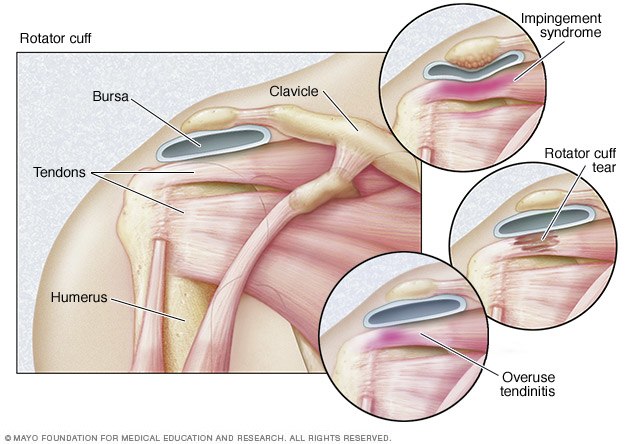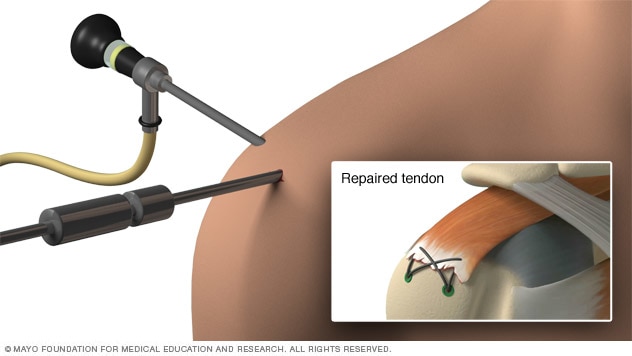Rotator cuff injury
Updated: 2023-05-11
Overview

Types of rotator cuff injuries
Rotator cuff injuries can range in severity from simple inflammation to complete tendon tears.
The rotator cuff is a group of muscles and tendons that surround the shoulder joint, keeping the head of the upper arm bone firmly within the shallow socket of the shoulder. A rotator cuff injury can cause a dull ache in the shoulder that worsens at night.
Rotator cuff injuries are common and increase with age. These injuries may occur earlier in people who have jobs that require repeatedly performing overhead motions, such as painters and carpenters.
Physical therapy exercises can improve flexibility and strength of the muscles surrounding the shoulder joint. For many people with rotator cuff problems, these exercises are all that's needed to manage their symptoms.
Sometimes, rotator cuff tears may occur from a single injury. In those circumstances, people should seek medical advice quickly because they might need surgery.
Symptoms
The pain associated with a rotator cuff injury may:
- Be described as a dull ache deep in the shoulder
- Disturb sleep
- Make it difficult to comb your hair or reach behind your back
- Be accompanied by arm weakness
Some rotator cuff injuries don't cause pain.
When to see a doctor
Your family doctor can evaluate short-term shoulder pain. See your doctor right away if you have immediate weakness in your arm after an injury.
Causes
Rotator cuff injuries are most often caused by progressive wear and tear of the tendon tissue over time. Repetitive overhead activity or prolonged bouts of heavy lifting can irritate or damage the tendon. The rotator cuff can also be injured in a single incident during falls or accidents.
Risk factors
The following factors may increase the risk of having a rotator cuff injury:
- Age. The risk of a rotator cuff injury increases with age. Rotator cuff tears are most common in people older than 60.
- Some occupations. Jobs that require repetitive overhead arm motions, such as carpentry or house painting, can damage the rotator cuff over time.
- Certain sports. Some types of rotator cuff injuries are more common in people who participate in sports like baseball, tennis and weight-lifting.
- Family history. There may be a genetic component involved with rotator cuff injuries as they appear to occur more commonly in certain families.
Complications
Without treatment, rotator cuff problems may lead to permanent loss of motion or weakness of the shoulder joint.
Diagnosis
During the physical exam, health care providers will press on different parts of the affected shoulder and move your arm into different positions. They'll also test the strength of the muscles around your shoulder and in your arms.
Imaging tests may include:
- X-rays. Although a rotator cuff tear won't show up on an X-ray, this test can visualize bone spurs or other potential causes for your pain — such as arthritis.
- Ultrasound. This type of test uses sound waves to produce images of structures within your body, particularly soft tissues such as muscles and tendons. It allows a provider to assess the structures of your shoulder during movement. It also allows a quick comparison between the affected shoulder and the healthy shoulder.
- Magnetic resonance imaging (MRI). This technology uses radio waves and a strong magnet. The images obtained display all structures of the shoulder in great detail.
Treatment

Arthroscopic rotator cuff repair
During an arthroscopic repair of a rotator cuff tendon, the surgeon inserts a tiny camera and tools through small incisions in the shoulder.
Conservative treatments — such as rest, ice and physical therapy — sometimes are all that's needed to recover from a rotator cuff injury. If your injury is severe, you might need surgery.
Therapy
Physical therapy is usually one of the first treatments suggested. Exercises tailored to the specific location of your rotator cuff injury can help restore flexibility and strength to your shoulder. Physical therapy is also an important part of the recovery process after rotator cuff surgery.
Injections
A steroid injection into the shoulder joint might be helpful, especially if the pain is interfering with sleep, daily activities or physical therapy. While such shots often provide temporarily relief, they also can weaken the tendon and reduce the success of future shoulder surgery.
Surgery
Many different types of surgeries are available for rotator cuff injuries, including:
- Arthroscopic tendon repair. In this procedure, surgeons insert a tiny camera (arthroscope) and tools through small incisions to reattach the torn tendon to the bone.
- Open tendon repair. In some situations, an open tendon repair may be a better option. In these types of surgeries, your surgeon works through a larger incision to reattach the damaged tendon to the bone.
- Tendon transfer. If the torn tendon is too damaged to be reattached to the arm bone, surgeons may decide to use a nearby tendon as a replacement.
- Shoulder replacement. Massive rotator cuff injuries may require shoulder replacement surgery. To improve the artificial joint's stability, an innovative procedure (reverse shoulder arthroplasty) installs the ball part of the artificial joint onto the shoulder blade and the socket part onto the arm bone.
Lifestyle and home remedies
The pain from a minor rotator cuff injury often diminishes on its own, with proper care. Stop doing what caused the pain and try to avoid painful movements. Limit heavy lifting or overhead activity until the shoulder pain subsides. Icing the shoulder may help it feel better. Over-the-counter pain relievers such as ibuprofen (Advil, Motrin IB, others) or acetaminophen (Tylenol, others) also may be helpful.
Preparing for an appointment
You'll probably start by seeing your family doctor or sports medicine physician. If your injury is severe, you might be referred to an orthopedic surgeon. If you've been treated for a similar problem in the past, you may need to bring past records and imaging studies with you to your appointment.
What you can do
Before the appointment, you might want to write a list that answers the following questions:
- When did you first begin experiencing shoulder pain?
- What movements and activities worsen your shoulder pain?
- Have you ever injured your shoulder?
- Have you experienced any symptoms in addition to shoulder pain?
- Does the pain travel down your arm below your elbow?
- Is the shoulder pain associated with any neck pain?
- Does your job or hobby aggravate your shoulder pain?
What to expect from your doctor
Your doctor is likely to ask you a number of questions. Being ready to answer them may reserve time to go over any points you want to spend more time on. Your doctor may ask:
- Where exactly is the pain located?
- How severe is your pain?
- What movements and activities aggravate or relieve your shoulder pain?
- Do you have any weakness or numbness in your arm?